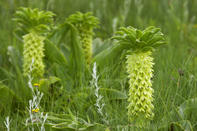The strange-looking pineapple lily is a striking bulbous plant resembling a flowering green pineapple. Native to South Africa, its yellow-greenish flowers are carried on long spikes with a tuft of green ‘leaves’ at the top.

Eucomis autumnalis is also called krulkoppie (Afrikaans), ubuhlungu becanti or isithithibala esimathunzi (in Xhosa) and umathunga, ukhokho or umakhandakantsele (in Zulu). Eucomis refers to the Greek eukomos - ‘beautifully haired’, while autumnalis refers to the flowering and fruit bearing season.
There are ten species in southern Africa found in moist montane grassland, riverbanks and forests from the Eastern Cape to the highlands of Zimbabwe.
Propagation is by offsets (when the bulb multiplies), seed or leaf cuttings. A striking garden plant, the pineapple lily is often planted en masse in rockeries where it can tolerate poor soil and winter rain, but will do well with rich soil.
Benefits of Pineapple Lily
Although the bulb is toxic, traditional healers use decoctions in water or milk as enemas for lower back pain, stomach aches, colic and flatulence. It can also help relieve hangovers, treat syphilis, break fevers and induce birth. Compounds (flavonoids) found in the pineapple lily have antispasmodic actions and is anti-inflammatory and antifungal.
Research by the University of Natal found that the pineapple lily leaves of young plants and the bulbs and root extracts of older plants exhibited higher anti-inflammatory activity, with levels increasing towards the end of the growing season.
This further validates the use of both leaves and bulbs of the pineapple lily in treating fever and pain associated with inflammation. In addition, E. autumnalis is the most commonly used herbal remedy for post-operative recovery and the treatment of bone fractures in South Africa.
The pineapple lily bulb is one of the most popular medicines used by traditional healers and extensive wild harvesting has put the plant under threat of over-exploitation and extinction. A study showed that the average size of the bulbs sold for medicine decreased significantly between 1995 and 2001. This was believed to be an indication of overexploitation.